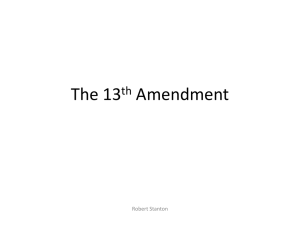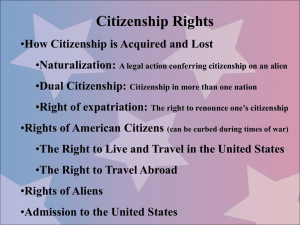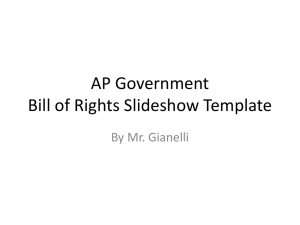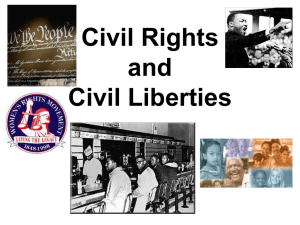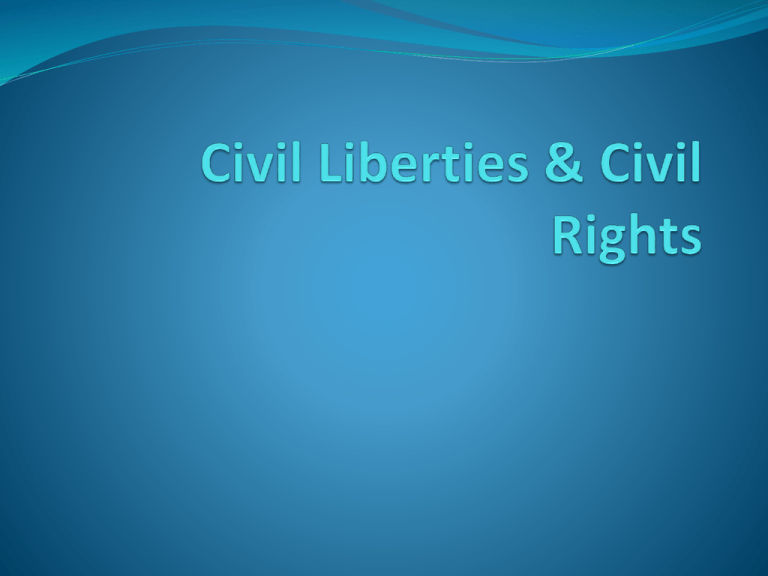
Principles of Civil Liberties and Civil
Rights
Differences
Civil liberties – constitutional protections of all persons against
governmental restrictions on the freedoms of conscience, religion,
and expression (basic freedoms)
Civil rights – constitutional rights of all persons to due process and
the equal protection of the law (discriminatory treatment)
Sources
The Constitution (no ex post facto laws, bills of attainder, habeas
corpus)
Bill of Rights, subsequent amendments (especially Amendments 1,
5, and 14)
Legislation (e.g. Civil Rights Acts of 1964, Voting Rights Act of 1965)
State constitutions
Principles of Civil Liberties and Civil
Rights
Important Considerations
Protections are not absolute—they may be exercised
only as long as they do not infringe upon the rights of
others
Your right to swing your arms ends just where the other man's
nose begins
Balancing test: courts balance individual rights and
liberties with society’s need for order and stability
Most rights and liberties are granted to all in the United
States, regardless of citizenship
Exceptions: non-citizens may not vote, serve on juries, staying
in the U.S. unconditionally, hold public office or certain
Principles of Civil Liberties and Civil
Rights
Impact of federalism
Framers believed that the Constitution limited government
enough. However, the state ratifying constitutions demanded
the addition of a Bill of Rights to protect citizens from the
federal government.
Bill of Rights was a protection against the national
governments and did not include protections against state
governments
1st Amendment – “Congress shall make no law…”
Barron v. Baltimore (1833) – 5th amendment limits only the powers of
the federal government
At the time of passage (1791), every state constitution
included a bill of rights
Principles of Civil Liberties and Civil
Rights
Impact of the Fourteenth Amendment (1868)
Due Process Clause – “no state shall deprive any
person of life, liberty or property without due process of
law”
Equal Protection Clause – “no state shall deny to any
person within its jurisdiction the equal protection of the
laws”
Gitlow v. New York (1925) began a process of selective
incorporation (gradual, case-by-case process of applying
the Bill of Rights to the states) that lasted from 1930s1960s & 2010 (McDonald v. Chicago)
Principles of Civil Liberties and Civil
Rights
Other rights applied to the state by selective incorporation:
Assembly
Petition
Religion
Search and seizure protections
Self-incrimination
Double jeopardy
Right to counsel
Right to bring witnesses
Right to confront witnesses
Cruel and unusual punishment protections
Which rights must be upheld comes from Palko v. Connecticut
(1937): any right that is “essential to a fundamental scheme of
liberty”
Freedom of Religion
Establishment clause: “Congress shall make no laws
respecting an establishment of religion…”
Came from colonial aversion to state-sponsored churches
Clearly prevents a state-sponsored church
Competing interpretations: Accomodationist view “Freedom
OF Religion” vs. Separationist view “Freedom FROM
Religion” (Jefferson and the “wall of separation” between
the two)
Incorporating case: Emerson v. Board (1947)
Engel v. Vitale (1962): recited prayer
Lemon v. Kurtzman (1971): aid to parochial school
Zelmon v. Simmons-Harris (2002): vouchers
Freedom of Religion
Free Exercise Clause: “…or prohibiting the free
exercise thereof;”
Provides freedom of worship and from burdens on
religious institutions
Religion cannot make an otherwise illegal act legal
Belief is always protected; practice is sometimes not (is:
Jehovah’s Witnesses not saluting the flag; not:
polygamy) – government must show a “compelling
interest” to restrict practice
Incorporating case: Cantwell v. Connecticut (1940)
Freedom of Speech and Press
Protected by the 1st and 14th Amendments at the federal and state
level (incorporating case: Gitlow and Near v. Minnesota (1941))
Involves both giving and hearing speech
Intended to protect expressing unpopular views
Not all speech is protected
“Clear and Present Danger” Test (FIRE!!! – not protected)
Libel – publication of statements known to be false that damage a
person’s reputation
New York Times v. Sullivan (1964): libelous statements only when false
and malicious in intent
Slander – Spoken defamation of character
Obscenity (Problem: what is obscene? Miller v. California (1973):
decisions should reflect local communities)
Symbolic speech (Tinker and Texas v. Johnson)
Freedom of Assembly
Right to gather together in order to make a statement
within reasonable limits
Government may impose time, place, and manner
restrictions
Incorporating case: DeJonge v. Oregon (1937)
Courts are reluctant to impose prior restraint
Freedom to Petition
Right to petition the government for a redress of
grievances – ask the government for action
Incorporating case: Edwards v. South Carolina (1963)
Constitutional basis for lobbying
Provides the basis for freedom of association
Political association (limited for federal employees by the
Hatch Act)
Private association
Due Process of Law
Due process of law: 5th and 14th Amendments prohibit the
government from denying life, liberty, or property without
due process of law
Procedural Due Process: “how” the law is applied
If the government is going to deny one of these rights, it must use
fair procedures to do so.
Violations: Illegal searches; Unfair court procedures
Substantive Process: “what” a government may or may not do
Not only does the government have to go about applying the law in
the right way, but the laws themselves must be fair
Courts focus on violations against enumerated rights of the Bill of
Rights, minority rights, rights necessary to participate in the political
process
Rights of the Accused
Search and Seizure Protection
Incorporating case: Wolf v. Colorado (1949)
Seizures (arrests) may conducted:
With a warrant issued upon “probable cause”
Without a warrant in emergencies, in cases of “hot pursuit”, or
when probable cause exists
Searches may be conducted:
With a warrant issued upon “probable cause”
Warrant must be specific: must state place to be searched and
objects to be searched for
This was a reaction to British general search warrants (writs of
assistance) issued during colonial times
Rights of the Accused
Exclusionary Rule
Prohibits evidence obtained by illegal searches or
seizure from being admitted in court; “fruit of the
poisonous tree”
Stems from freedom from unreasonable searches and seizures
(4th Amendment) and protection against self-incrimination
(5th Amendment)
Incorporating case: Mapp v. Ohio (1961)
Rights of the Accused
Protection From Self-Incrimination
Fifth Amendment provides this right: “…nor shall be
compelled in any criminal case to a witness against himself…”
Incorporating case: Malloy v. Hogan (1964)
Miranda warnings (Miranda v. Arizona (1966)) are necessary
for any suspect taken into custody
Right to Counsel
Incorporating case: Powell v. Alabama (1932) for capital cases,
Gideon v. Wainwright (1963) for felony cases
State must provide legal help for those who cannot afford it –
included in Miranda warnings
Rights of the Accused
Excessive bail and fines
8th Amendment; Incorporation is questionable
Bail set must bear some relationship to:
Seriousness of the offense
Likelihood that the suspect will flee if bail is posted
*Denial of bail does not constitute excessive bail
Cruel and Unusual Punishment
Banned by 8th Amendment
Most of the debate on the issue has centered on the application
Laws vary from state to state, but legal after Gregg v. Georgia (1976)
Cannot be mandatory; protection for 16- and 17-year olds as well as the mentally
handicapped from the death penalty
Recent decline attributed to DNA testing and public concerns over wrongful
sentences
Punishment must be proportionate to the crime
Three strikes rule has been upheld
Right to Privacy
Not specifically granted in the Constitution. However,
the following provisions imply a right to privacy:
Amend. I – guarantee of freedom of religion
Amen. III – prohibition against quartering
Amen. IV – search and seizure protections
Amen. V – protection of private property seizure
without due process
Defined by the opinion in Groswold v. Connecticut
(1965) – prohibition of contraceptives violated the
right to marital privacy
Precedent that was used in Roe v. Wade (1973)
Understanding Civil Liberties
Civil Liberties and Democracy
People need the right to express themselves
Courts continue to define the limits of liberties
Civil Liberties and the Scope of Government
Must decide the line between freedom & order
Since Americans can no longer avoid the attention of
government, strict limitations on governmental power
are essential—limitations that are provided by the Bill of
Rights (Freedom v. Order debate)
In general, civil liberties limit the scope of government
Civil Rights: An Overview
Civil rights are the constitutional rights of all persons to
due process and the equal protection of the law
Policies designed to protect people against arbitrary or
discriminatory treatment by government officials of
individuals
Issue: Is an increase in the scope of government to protect
some people’s rights an unacceptable threat to the rights of
others?
Issue: Are the differences in treatment reasonable?
Most Americans favor equality as an abstract concept, but
the concrete struggle for equal rights (think 14th
Amendment) under the law has been a bitter struggle
The Struggle For Equal Justice
Racial Equality
The end of the Civil War brought the 13th, 14th, and 15th Amendments
and the legislative support to achieve their aims
Supreme Court struck down many of these laws and limited the construction of
the amendment; progress towards equality was not a reality again until the 1950s
and 60s
Migration Northward following World War I created a voting African
American middle class that opposed segregation
Brown v. Board of Education (1954) decision began the push towards
equality by breaking down many of the legal barriers to integration
Executive branch used its authority to integrate the military and federal
bureaucracy in the 1940s and 50s
Federal Civil Rights Acts of 1957 became the first civil rights legislation
since Reconstruction
Civil Rights Era
Political participation (largely unconventional) brought attention to the issue of
equal rights and segregation
Civil Rights Act of 1964 forbid discrimination on the basis of race, color, religion,
sex, or nationality
Legislation and key Supreme Court decisions continued to push the
nation towards racial equality
The Struggle For Equal Justice
Gender Equality
The push for women’s rights began with the Seneca Falls Women’s
Rights Convention (1948), but during the Civil War, women were
encouraged to devote their efforts toward ending slavery instead
States (starting with WY) slowly began granting women suffrage, but
the ultimate goal was federal suffrage – 19th Amendment (1920)
Equality was still not met (e.g., pay and treatment)
Successes (i.e. sexual harassment protections) and failures (i.e. Equal
Rights Amendment) have led to current state of what is seen as still
limited progress for women’s rights
Other minority groups
Hispanics (targeted in immigration debate)
Asian Americans (Chinese Exclusion Act and Japanese internment
camps)
Native Americans (historic discrimination from the beginning of the
U.S.)
Applying Equal Protection
Constitution does not prevent all discrimination, but
unreasonable or arbitrary classifications (age restrictions on
voting, marrying, and driving appear as reasonable)
Three tests to distinguish classifications
Rational basis test
Petitioning party must prove that law has no reasonable relationship to a
proper purpose of government (substantive due process)
Cannot be used if the case involves a suspect classification (treatment on
basis of race or national origin), almost-suspect classification, or a
fundamental right
Strict scrutiny test
Government must show that discrimination of a suspect classification
has a “compelling interest” to constitutionally justify the discrimination
Heightened scrutiny test
Government must show that its classification served “important
governmental objectives”
Applies to quasi-suspect classifications: sex
Voting Rights
Although states are given the power to regulate voting, Congress may
supersede these regulations according to Article I, Section 4
After passage of the 15th Amendment, officials sought to undermine the
right of African-Americans to vote
Literacy tests, poll taxes, white primaries, intimidation and violence
Court began to protect African-American rights in the 1940s
White primaries declared unconstitutional in Smith v. Allwright (1944)
Racial gerrymandering declared violating the 15th Amendment in Gomillion
v. Lightfoot (1960)
24th Amendment forbid poll taxes in national elections and Harper v. Board
of Elections (1966) applied the 14th Amendment to forbid all poll taxes
Voting Rights Act of 1965
Prohibits voting qualifications that result in the denial of the right to vote
on account of race or color
DOJ has the right to review changes that may result in voting power losses
Shelby County v. Holder (2013) disallowed the formula that was used to
decide which states needed pre-clearance to change voting laws (Section
IV)
Equal Opportunity
Congress’ authority to legislate against discrimination by
private individuals comes from broad construction of the
Commerce Clause
Title II of the Civil Rights Act of 1964 applied anti-
discrimination to places of public accommodation
Title VII created the Equal Employment Opportunity
Commission to enforce anti-discriminatory hiring practices
Supreme Court rulings outlawed restrictive covenants
and 1968 Fair Housing Act forbid discrimination in
housing because of race, color, religion, national origin,
sex, or physical handicap
Education Rights
Brown ruling overruled Plessy by asserting that separate is necessarily
unequal
Swann v. Charlotte-Mecklenburg (1971) allowed busing to remedy the
effects of de jure segregation, but not de facto segregation
In time, mandatory busing has been largely eliminated and race-
conscious school assignment plans have been ruled unconstitutional
Affirmative action has sought to remedy past barriers to employment
and education
UC Regents v. Bakke (1978) addressed the perceived reverse
discrimination from affirmative action by allowing affirmative action
(“plus” system), but ruled against quota systems
“Individual consideration” must be given
Gratz v. Bollinger (2003) declared Michigan’s point system as too
mechanical for undergraduates and barely upheld the law school’s
system in Grutter v. Bollinger (2003) because it did not use a point
system
Discussion
How could the Supreme Court rule that segregation
was constitutional?
What was the Court’s argument in overruling Plessy?
Suppose it could be proved that segregation did not
have a detrimental effect on African American
children. Would this require that the Court—in the
interests of logical consistency—rule differently in
Brown?
Discussion
How did the Court move from (a) interpreting the
Fourteenth Amendment to mean that African Americans
cannot be relegated to particular schools because of their
race to (b) requiring that a particular racial balance must
exist in schools? Why was it important that the first
busing cases to come to the Court were from southern
states that had practiced de jure segregation?
What similarities and differences can you discern between
the African American civil rights movement and that for
women? Latinos? Gays and lesbians? Are these
differences primarily historical, cultural, or legal? How do
those differences affect the remedies necessary to protect
these individuals’ civil rights?



